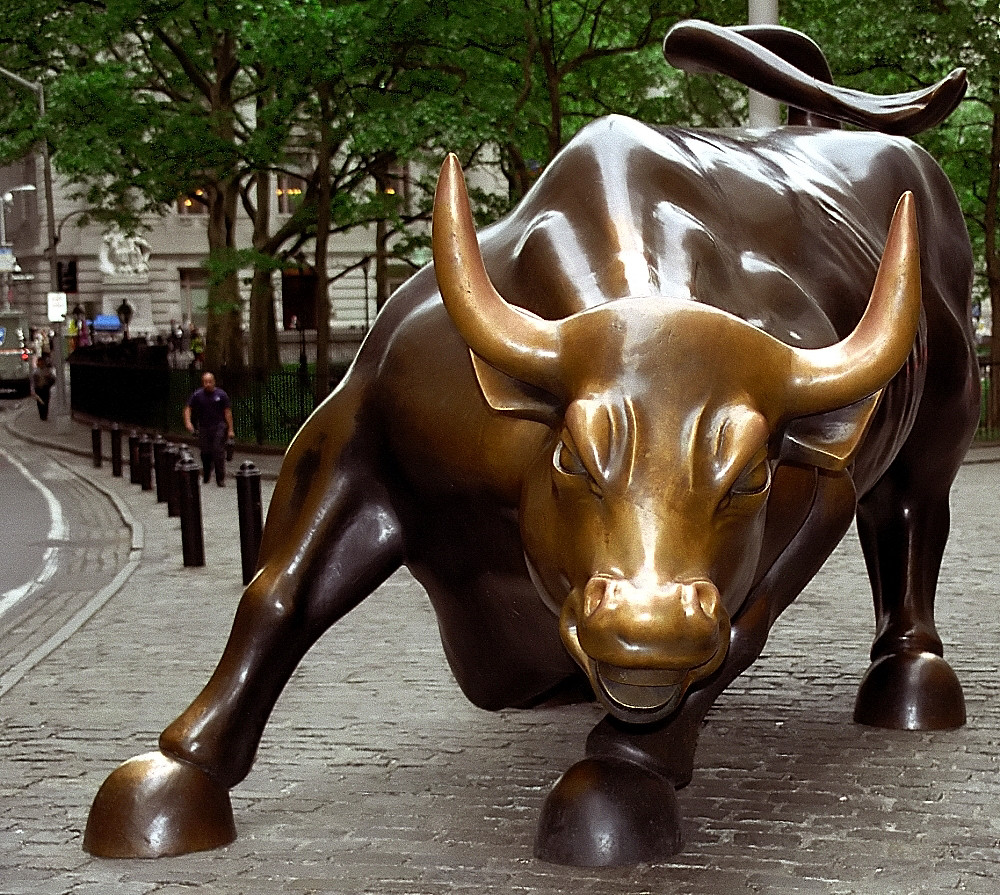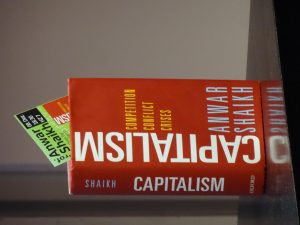Trump’s Other Wall
✑ JACK RASMUS` ╱ ± 4 minutes


Trump’s trade war, his provoking of a global currency war, his monetary policy of forcing the Fed to lower rates all exacerbate the Wall of Money inflow to the US and hasten the decline of the global economy.

He thinks that is great news for the US economy. But it’s quite the opposite.

Trump’s trade war, his provoking of a global currency war, his monetary policy of forcing the Fed to lower rates all exacerbate the Wall of Money inflow to the US and hasten the decline of the global economy.
From: Jack Rasmus, August24, 2019. ╱ About the author
Dr. Jack Rasmus, Ph.D Political Economy, teaches economics and politics at St. Mary’s College in California. He is the author and producer of the various nonfiction and fictional workers, including the recently published ‘Central Bankers at the End of Their Ropes: Monetary Policy and the Coming Depression’, Clarity Press, August 2017; ‘Looting Greece: A New Financial Imperialism Emerges’, Clarity Press, October 2016; and ‘Systemic Fragility in the Global Economy’, Clarity Press, January 2016. His website is: http://www.kyklosproductions.com and twitter handle, @drjackrasmus.
Trump brags about the ‘wall of money’ now flowing into the US from abroad – from Europe, Asia, emerging market economies – as the global economy slides into recession there faster than in the US. He thinks that is great news for the US economy. But it’s quite the opposite.
Behind the Wall of Money inflow is $17 trillion in negative interest rates in Europe and Japan that is driving money out of those economies and into US Treasuries as a ‘safe haven’, causing a rise in the dollar relative to other currencies and causing currencies worldwide outside the US to fall in turn. As other currencies fall, capital flight from their economies (Europe, Latin America, Asia) sends still more dollars to the US – driving the dollar higher still. A vicious cycle ensues: declining currencies leads to more capital flight, to more demand for US$, to rising dollar value, to further decline in other currencies, etc. Investment collapses and recessions deepen further outside the US.
US Multinational corporations doing business in other countries see their profits rapidly eroding in those economies, as the currencies in the countries in which they’re doing business collapse. They then rush to convert their Pesos, Euros, Rupees, etc. into dollars as quickly as possible and repatriate their offshore profits back to the US. The result: the US$ rises still more.
Trump’s trade war has a similar negative compounding effect as negative rates offshore, capital flight, and multinational corporation repatriation: Today’s slowing global economy (already in a manufacturing recession everywhere including the US) is largely driven by business investment contracting in the face of uncertainty due to Trump’s trade war. That uncertainty and declining investment leads to central banks worldwide reducing their interest rates in a desperate effort to stimulate their economies, which is now happening. But lower interest rates in Europe, Emerging markets, etc. has the negative effect of depressing the value of their currencies still further – leading to even more capital flight to the US, buying up more US Treasuries, and driving up the US $ even more. In other words, Trump’s trade war is also driving the Wall of Money to grow further.
But the Wall of Money is a symptom and represents the global economy outside the US sliding deeper into recessions – a global economic decline that is now spilling over to the US economy.
What’s Trump’s solution? Trump browbeats the Federal Reserve to get Powell, its chair, to lower rates, in the hope lower rates will discourage capital inflow to the US (i.e. the Wall) and thus slow the rise of the dollar. But global recession and the ‘wall of money’ now more than offset any Fed rate cuts effect on the US$. Meanwhile, Trump’s monetary policy (lower interest rates) accelerates the wall of money inflow further by forcing the central banks of other economies to lower their rates still further.
Trump policies have also set off a global currency war, which is about to intensify as he targets China’s Yuan-Reminbi. China is already responding by allowing the Yuan to slowly devalue to offset Trump’s tariffs on China exports. Devaluation of the Yuan forces other economies to devalue their currencies further, as their central banks lower their interest rates further, in Europe and Japan that means even deeper negative rates and more capital flight to US Treasuries and an even higher US$.
In short, Trump’s trade war, his provoking of a global currency war, his monetary policy of forcing the Fed to lower rates all exacerbate the Wall of Money inflow to the US and hasten the decline of the global economy.
Trump has not only clearly now lost control of trade negotiations with China. He has lost control of US monetary policy with the Fed that now refuses to be stampeded, he has lost control of any stabilization of the US dollar, and he has accelerated forces that are driving the global economy into recession.
And it’s only a matter of time–a short time – before it’s also clear he’s lost control of the US economy as well.
Jack Rasmus is author of the forthcoming book, ‘The Scourge of Neoliberalism: US Policy from Reagan to Trump’, Clarity Press, October 1, 2019. His website is http://kyklosproductions.com and twitter handle @drjackrasmus.
For more discussion on this topic, listen to my April 12, 2019 radio show, Alternative Visions, on the Progressive Radio Network, where I discuss the dimensions of the greatest single redistribution of income to the rich from the rest in American history.
To listen go to:
Radio show announcement:
Trump brags about the ‘Wall of Money’ coming into the US from abroad. But what it represents is a global economy deteriorating fast and offshore investors sending their money to US safe haven of Treasuries. How the ‘wall’ is driving up the $US, negating Trump’s tariffs, and negating any trade deal with China. Trump turns up the ‘blame game’ for economy weakening: tantrums against China’s new tariffs, the Fed’s Powell foot dragging on lowering interest rates, and Dems refusing to give more tax cuts to investors. Why Fed rate cuts won’t stimulate the economy. Why Trump’s new proposed tax cuts won’t either. Trump’s next desperate moves to manipulate currencies (US and China’s) that will intensify the emerging currency war. Other topics of the show: debunking Trump’s payroll tax cut idea, why US steel companies are laying off workers in Michigan, and what’s behind the Japan-So. Korea ‘pissing match’ (yup, it’s trade).
Behind the Wall of Money inflow is $17 trillion in negative interest rates in Europe and Japan that is driving money out of those economies and into US Treasuries as a ‘safe haven’, causing a rise in the dollar relative to other currencies and causing currencies worldwide outside the US to fall in turn. As other currencies fall, capital flight from their economies (Europe, Latin America, Asia) sends still more dollars to the US – driving the dollar higher still. A vicious cycle ensues: declining currencies leads to more capital flight, to more demand for US$, to rising dollar value, to further decline in other currencies, etc. Investment collapses and recessions deepen further outside the US.
US Multinational corporations doing business in other countries see their profits rapidly eroding in those economies, as the currencies in the countries in which they’re doing business collapse. They then rush to convert their Pesos, Euros, Rupees, etc. into dollars as quickly as possible and repatriate their offshore profits back to the US. The result: the US$ rises still more.
Trump’s trade war has a similar negative compounding effect as negative rates offshore, capital flight, and multinational corporation repatriation: Today’s slowing global economy (already in a manufacturing recession everywhere including the US) is largely driven by business investment contracting in the face of uncertainty due to Trump’s trade war. That uncertainty and declining investment leads to central banks worldwide reducing their interest rates in a desperate effort to stimulate their economies, which is now happening. But lower interest rates in Europe, Emerging markets, etc. has the negative effect of depressing the value of their currencies still further – leading to even more capital flight to the US, buying up more US Treasuries, and driving up the US $ even more. In other words, Trump’s trade war is also driving the Wall of Money to grow further.
But the Wall of Money is a symptom and represents the global economy outside the US sliding deeper into recessions – a global economic decline that is now spilling over to the US economy.
What’s Trump’s solution? Trump browbeats the Federal Reserve to get Powell, its chair, to lower rates, in the hope lower rates will discourage capital inflow to the US (i.e. the Wall) and thus slow the rise of the dollar. But global recession and the ‘wall of money’ now more than offset any Fed rate cuts effect on the US$. Meanwhile, Trump’s monetary policy (lower interest rates) accelerates the wall of money inflow further by forcing the central banks of other economies to lower their rates still further.
Trump policies have also set off a global currency war, which is about to intensify as he targets China’s Yuan-Reminbi. China is already responding by allowing the Yuan to slowly devalue to offset Trump’s tariffs on China exports. Devaluation of the Yuan forces other economies to devalue their currencies further, as their central banks lower their interest rates further, in Europe and Japan that means even deeper negative rates and more capital flight to US Treasuries and an even higher US$.
In short, Trump’s trade war, his provoking of a global currency war, his monetary policy of forcing the Fed to lower rates all exacerbate the Wall of Money inflow to the US and hasten the decline of the global economy.
Trump has not only clearly now lost control of trade negotiations with China. He has lost control of US monetary policy with the Fed that now refuses to be stampeded, he has lost control of any stabilization of the US dollar, and he has accelerated forces that are driving the global economy into recession.
And it’s only a matter of time–a short time – before it’s also clear he’s lost control of the US economy as well.
Jack Rasmus is author of the forthcoming book, ‘The Scourge of Neoliberalism: US Policy from Reagan to Trump’, Clarity Press, October 1, 2019. His website is http://kyklosproductions.com and twitter handle @drjackrasmus.
Listen to more discussion on this topic
For more discussion on this topic, listen to my April 12, 2019 radio show, Alternative Visions, on the Progressive Radio Network, where I discuss the dimensions of the greatest single redistribution of income to the rich from the rest in American history.
To listen go to:
Radio show announcement:
Trump brags about the ‘Wall of Money’ coming into the US from abroad. But what it represents is a global economy deteriorating fast and offshore investors sending their money to US safe haven of Treasuries. How the ‘wall’ is driving up the $US, negating Trump’s tariffs, and negating any trade deal with China. Trump turns up the ‘blame game’ for economy weakening: tantrums against China’s new tariffs, the Fed’s Powell foot dragging on lowering interest rates, and Dems refusing to give more tax cuts to investors. Why Fed rate cuts won’t stimulate the economy. Why Trump’s new proposed tax cuts won’t either. Trump’s next desperate moves to manipulate currencies (US and China’s) that will intensify the emerging currency war. Other topics of the show: debunking Trump’s payroll tax cut idea, why US steel companies are laying off workers in Michigan, and what’s behind the Japan-So. Korea ‘pissing match’ (yup, it’s trade).
| Top image: Wall of Money. From: SE. |
|---|






















Comments
Post a Comment
Your thoughts...